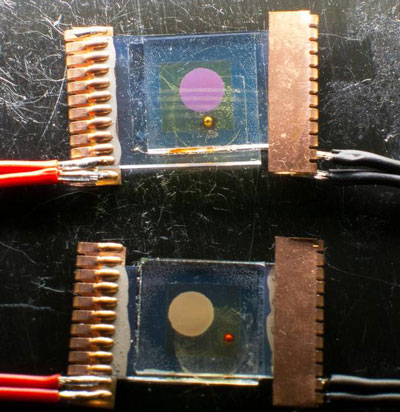| May 02, 2012 |
Towards low-cost solar cells based on abundant metals
|
|
(Nanowerk News) Following the tragic effects of the Tsunami in 2011, there is an imperative to find energy sources to replace nuclear power. Many technologies are actively under investigation, but a neglected aspect is the sustainability of the material requirements. A highly efficient process based on extremely rare materials is unlikely to enter the mainstream. In an article in the flagship journal Chemical Communications, chemists of the University of Basel describe a paradigm-shifting approach to sustainable and renewable photovoltaic devices.
|
|
Dye-sensitized solar cells (DSCs) consist of a semiconductor, titanium dioxide, which is coated with a colored dye. The dye absorbs sunlight and injects an electron into the semiconductor. This is the primary event leading to the photocurrent. Researchers Nik Hostettler and Ewald Schoenhofer in the group of Professors Ed Constable and Catherine Housecroft from the University of Basel have made two breakthroughs (see paper in Chemical Communications: "The d10 route to dye-sensitized solar cells: step-wise assembly of zinc(II) photosensitizers on TiO2 surfaces").
|
 |
| Comparative testing of ruthenium and zinc dye-sensitized solar cells.
|
|
Firstly, they have developed a new strategy for making and attaching colored materials to the surface of titanium dioxide nanoparticles and, secondly, they have shown for the first time that simple compounds of the readily available metal zinc may be used. Project Officer Dr Biljana Bozic says that the key discovery was finding a method for the simultaneous synthesis of the dye and its attachment to the semiconductor surface.
|
|
Colorful dyes from gray zinc
|
|
The discovery that zinc dyes can be used is most unexpected. Constable states that most chemists consider zinc to be a "boring" element, as most of its compounds are colourless. However, in course of other work related to next-generation lighting devices, his team discovered new highly-colored organic compounds that could bind to zinc to give new coloured materials. Although the devices are not yet particularly efficient, this observation opens the way to new generations of DSCs with hitherto unconsidered types of dyes.
|
|
Conventional DSCs use ruthenium dyes, but ruthenium is very rare and expensive (3,500 Swiss Francs/2,990 Euro per kilogram). Recently, this research team demonstrated that dyes from abundant and relatively inexpensive copper (7.5 Swiss Francs/6.3 Euro per kilogram) were effective in DSCs and the extension to cheap zinc (1.8 Swiss Francs/1.5 Euro per kilogram) compounds further increases the sustainability of the materials science. "This is a significant step towards our dream of coupling photovoltaics and lighting in an intelligent curtain which can store solar energy during the day and function as a lighting device at night. This is at the core of our ERC research programme Light-In, Light-Out", Ed Constable comments.
|

